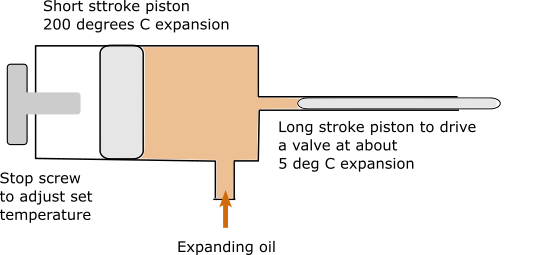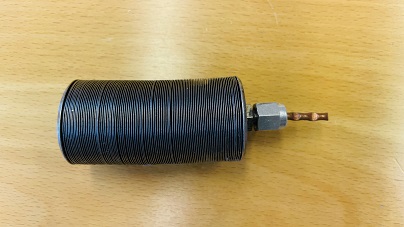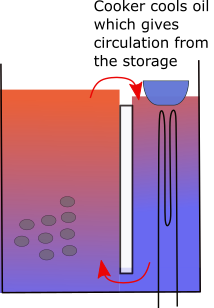Temperature control: Actuators
Some experiences we have on testing different types of actuators are listed below.
Sensors and magnetic actuators The piston storage system was tested using thermocouples, a solenoid actuator and a slider-based two-way valve, with a LabView based control program. This served to demonstrate the piston system, but violates the aim of being simple and fully mechanical. Further tests were made with mechanical actuators and without thermal sensors. |
 |
Dual piston actuator Expanding oil has been tested as a driving force for a hydraulic piston actuator. As a coil with oil is heated, the expansion from ambient to a set temperature is taken with a large diameter piston. As the piston meets a stop screw (to adjust the set temperature) the further expansion is by a small diameter piston, giving a large stroke to drive the valve for the further small temperature changes. This works fine, but a return spring is needed on the piston as the oil would tend to boil rather than retract the piston upon oil contraction. The piston must, however, be fabricated with quite high precision. |
 |
Bellows actuator A slider valve was tested with a metal bellows containing a fluid with boiling point at about 175 degrees C at atmospheric pressure. The bellows would then expand and drive the valve. The concept was not pursued further as the contraction during cooling (condensation) came at delayed temperatures (sub-cooling before condensation). |
 |
Bimetal spring A concept with a bi-metal spring was successful. We applied it for a one-way case, but it can also be adopted to a two way valve. The spring turns an inner pipe located inside an outer pipe and oil flows through the pipes when a holes in the two pipes overlap. |
 |
Expansion based flow control For the expansion based flow control system, the flow is controlled by a barrier for overflow. This can be in the form of mechanical barrier adjustment or in the form of a displacement body adjusting the height of both the hot and the cold oil interfaces. |
 |